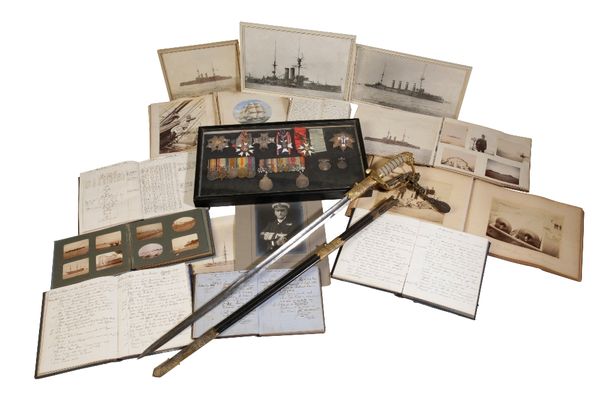Bidding ended. Lot has been sold.
THE HISTORICALLY SIGNIFICANT GROUP TO THE FIRST COMMANDER OF THE AUSTRALIAN FLEET, ADMIRAL SIR GEORGE EDWIN PATEY. K.C.M.G, K.C.V.O
Sold by direct order of the family
A Naval General Service Medal bar Syria, correctly impressed ‘G.E.Patey Mate' and St Jean D'Acre Medal George Edwin Patey was the father of Sir Patey. He was born in Kingsbridge in 1814. He joined the Navy as a Volunteer in 1826 and was promoted to Midshipman in 1830. He was appointed to H.M.S Carysfort, 26 guns, as Mate in January 1837. "Caryfort" was on the fleet under Admiral Sir R Stopford, which took part in the operations off the coast of Syria.
At the Bombardment of Acre, "Carysfort" and " Castor were next to each other in order against the Western line batteries. His brother Charles (Admiral Charles George Edward Patey C.M.G.) was serving on "Castor" as a Lieutenant.
George Edwin was promoted to Lieutenant in November 1840 in recognition of his services on the Coast of Syria. Awarded the NGS bar Syria and the St Jean D'Acre Medal, both medals confirmed on the rolls.
After serving on various ships, George Edwin was appointed First Lieutenant of "Agincourt", 72 guns, Flagship of the East Indies Squadron. While serving on "Agincourt", he took a very active part in an expedition to capture and destroy forts and batteries on the River Brune in Borneo to punish the Sultan of Borneo for atrocities he had committed. The expedition was under the direct command of the Admiral. A large number of ships' boats were commanded by Captain G R Munday, with Lieutenant G.E Patey as his second in command. A heavy fire opened on the advancing boats from the forts protecting the town of Pulo Bungore. The London Gazette of 22nd September 1846 states:
"The Gunboats, commanded by Captain Munday of the "Isis", and assisted by Lieutenant George Edwin Patey, First lieutenant of the "Agincourt", with rapidity cast off the steamers, formed a line and opened fire, and so soon as the enemy fire slackened, pushed for the shore and gallantly mounted the steep ascent to the fort; but from whence the Garrison retreated precipitately, leaving the Sultan's flag to be hauled down by the assailants"
Captain Munday in his report mentioned with approval " the conduct in very trying circumstances of Lieutenant G . Edwin Patey" By the London Gazette on 27th October 1846, Lieutenant George Edwin Patey was promoted to Commander, his commission to the bear the date of 8th July 1846, the day after the capture and destruction of the forts and batteries on the River Brune.
George served as Commander on H.M.S Rodney, 92 guns, and in command of H.M.S. Flying Fish, 12 guns, on the West Coast of Africa, until December 1851, when he was promoted Captain, at the very early age for peacetime of 37. It is believed he was the youngest Royal Navy Captain at the time.
He was appointed to Command H.M.S. Monarch, 54 duns, on the Pacific Station in December 1854, the commission lasting until early 1858. He had married Mary Rundle in February 1852.
At the end of "Monarch's" commission, he went to half pay and later commanded H.M.S. Centurian, 80 guns, in the Mediterranean and Channel Fleet and then was appointed to H.M.S. Pembroke for Coast Guard Service in the Harwich District and in April 1861, to H.M.S Colossus for Coast Guard Service in the Portland Roads. He became seriously ill, his ailment being described as " intestinal Colic" and died at Weymouth on 4th May 1862. Patey was laid to rest in the family vault in Plymouth Old Cemetery.
Condition VF+ ( Suspender a little loose, Syria bar slightly bent, edge bruise after naming)
Sir Patey group
K.C.M.G Neck Badge.
K.C.M.G. Breast Badge, Centre and pin on reverse solid gold.
K.R.V.O. Neck badge numbered K293.
K.R.V.O. Breast Badge, numbered 293, with solid gold pin and rivets to reverse.
Knight grade French Legion of Honour, 3rd republic.
Spanish order of Naval Merit – Grand Star Cross
Zulu War Medal, correctly engraved A G Sub Lt G E Patey RN HMS Shah
1914/15 Star, correctly impressed V. ADML, Sir. G.E. Patey. K.C.V.O
British War Medal, correctly impressed V. ADML, Sir. G.E. Patey
Victory Medal, correctly impressed V. ADML, Sir. G.E. Patey
1911 Coronation medal.
With the miniature group, court mounted.
Also entitled to The Greek Order of the Redeemer.
The condition of Medals is EF+
Sir George Edwin Patey was born at Montpelier House, in Plymouth on 24th February 1859. The Patey family had a long tradition of service in the Royal Navy and following in his father's footsteps he entered the Navy as a Cadet on the 15th January 1872, aged 12.
After completing two years training at H.M.S Britannia, he joined his first ship H.M.S Revenge, he was quickly transferred to H.M.S Northumberland, and on 19th March 1874 he was promoted to Midshipman. The ship's company of Northumberland was transferred to H.M.S. Black Prince. After two years, Patey transferred to H.M.S Shah, which was fitting out for service in the Pacific as the flagship of Rear Admiral de Horsey.
In December 1876, Shah sailed for the Pacific, soon after her arrival she was involved in the ‘Battle of Pacoha' an along with HMS Amethyst engaged the rebel ship Huascar. he action saw the first use of the newly commissioned self-propelled torpedo.
While still serving on Shah, he went ashore during The Anglo – Zulu War in the Naval Brigade. Although it doesn't seem he was involved in a great deal of action, he was awarded the Zulu War Medal.
Patey was promoted to Lieutenant on 10th August 1881, he then trained in Gunnery, being based on H.M.S Excellence for three years. Promoted to Commander on 3rd December 1894, he later served in Naval Intelligence. His next appointment was to H.M.S Barfluer, serving on her during the Allied Occupation of Crete on 15th February.
A return to Naval intelligence was made after being promoted to Captain on 1st January 1900. He served as Assistant Director of Naval intelligence until May 1901.
On 23rd April 1903 while in command of H.M.S Venerable, he was appointed to the Royal Victorian Order by Edward VII. He held command of H.M.S Implacable between 1905 and 1907. He was then made Aide-|De-Camp to Edward VII until promotion to Rear Admiral on 2nd January 1909, with British Home Fleet and was commander of the 2nd Battle Squadron until 1911. The Prince of Wales, later to be King Edward VIII, served for a short period as Patey's Aide – de – Camp. On his leaving the 2nd division he sent a letter and signed pictured to Patey.
‘Queensferry H.M.S. "Hindustan
2nd Div. Home Fleet
October 10th 1911.
Dear Admiral Patey,
I am writing this letter to wish you good-bye again, and am sending this photograph in remembrance of my happy time on board H.M.S. Hindustan in the 2nd Division.
Wishing you every success in the future
I remain,
Yours very sincerely
Edward P.
In 1913, Patey was seconded to the Australian Navy and became the first Rear Admiral Commanding HM Australian Fleet. In this role, he was awarded Knight Commander of the Royal Victorian Order.
Patey was commanding the Australian Naval Squadron at the Outbreak of the Great War his ship being HMAS Australia; the Squadron was involved in the capture of German Soma and German New Guinea. With his ship HMAS Australia, he joined the 2nd Battlecruiser Scotland of Scotland in 1915, with ‘ Australia' serving as the Flag Ship. He served as Commander-in-Chief, North America and West Indies Station from March 1915.
In August 1916 he passed the command to Admiral Browning and thus his active service career was over after 44 years. He was promoted to full admiral on 1st January 1918 and placed on the retired list on 1st January 1919.
In late 1919 Patey was awarded £2000.00 in Naval Prize money for having participated in the capture of a ship. He had a happy retirement and enjoyed fishing and hunting.
Patey passed away 20 days short of his 76th birthday from Pleurisy.
The group includes a diary January 1901 to June 190. Captain's Night Order Book HMS Venerable November 1902 – October 1904. Ships Journal for Iron Duke and HMS Telfer covering July 1881 to October 1882, signed by Patey. Logbook for HMS Balfour Feb 1895 to October 1896. Two Certificate size invitations inviting Patey and his wife to the Coronation of EVII. Log for HMS Shah March 1878 onwards. Three family photograph albums. Photograph Album of his time in South Africa, showing a number of Zulu Tribesman. A large photograph album showing ships he served on and fellow officers. Victorian Naval Sword, Admiral grade, sadly in average condition with rust to the blade.
Read more

